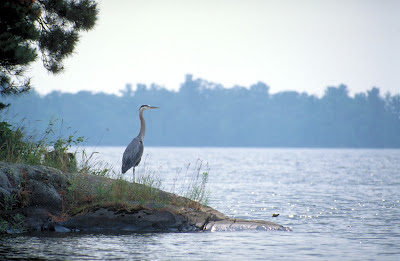“The report from the multi-institution EcoFore-Lake Erie project states that a 46 percent reduction in the amount, or load, of phosphorus pollution would be needed to shrink Lake Erie’s Central Basin hypoxic zone to a size last seen in the mid-1990s—a time that coincided with the recovery of several recreational and commercial fisheries in the lake’s west and central basins.Phosphorus is a nutrient used in crop fertilizers. Excess phosphorus washes off croplands during rainstorms and flows downstream in rivers that feed the Great Lakes. Once in the lakes, phosphorus can trigger algae blooms. When the algae die and sink to the lake bottom, oxygen-consuming bacteria feed on them and create hypoxic zones in the process. Many fish shun these oxygen-starved waters, which significantly reduce the amount of suitable habitat available to the fish.The study, accepted for publication in a forthcoming edition of the Journal of Great Lakes Research, calls for Central Basin phosphorus reductions considerably higher than other recent recommendations, including a proposal issued last year by the Ohio Lake Erie Phosphorus Task Force aimed at avoiding Western Basin toxic algae blooms. The new report is a synthesis of the major findings from the EcoFore-Lake Erie project, created in 2005 and supported by the U.S. National Oceanic and Atmospheric Administration’s Center for Sponsored Coastal Ocean Research.”
Category:
Lake Erie “dead zone” research includes work by IISG specialist
March 3rd, 2014 by iisg_superadminWisconsin students learn about Great Lakes cleanup
December 10th, 2012 by Irene MilesCaitie writes, “I visited Sheboygan, Wisconsin last Tuesday and spoke to high school biology students, answering questions about the Great Lakes Legacy Act dredging project happening just two miles from their school. This was my final school to visit in Sheboygan as part of a 12-school, countywide tour, which began this past October and reached about 600 high school science students. Now the students know the purpose of a cleanup happening right in their downtown, and they understand the science behind it.

This project is part of a larger effort to provide students with stewardship opportunities and supplemental hands-on education about remediation and restoration efforts throughout the Great Lakes. It has been great to work with students in Sheboygan and Northwest Indiana, and I look forward to bringing this program to more Great Lakes students soon.”
Sea Grant staff take to the sea for research
August 10th, 2012 by Irene Miles| Community outreach specialist Kristin TePas rinses a PONAR dredge used to collect sediment containing benthic organisms. |
| IISG Great Lakes ecosystem specialist Paris Collingsworth deploys a net to collect zooplankton. |
“The Great Lakes National Program Office (GLNPO) of the U.S. Environmental Protection Agency (USEPA) is responsible for monitoring the offshore water quality of the Great Lakes to evaluate water quality over time and identify any emerging water quality problems. Comprehensive water quality surveys are conducted in all five Great Lakes in both the spring, when the water is cold and well mixed, and in the summer, when the lakes are biologically active. The R/V Lake Guardian is currently being used to conduct the summer water quality survey.”
Educators set sail on Lake Huron
July 31st, 2012 by Irene MilesGLRRIN Lake Michigan partners examine future of Lake Michigan food webs
April 11th, 2012 by Irene MilesThe term “food web” is used to describe the intricate relationships between the many different plants, animals, and organisms that can exist in small or large areas. Understanding food webs in specific environmental locations, such as in one or more of the Great Lakes, can help researchers and communities better respond to changes in those delicate systems. Invasive species are just one example of a potential influence that can drastically alter a food web and have substantial impacts on native environments.
Recent News
IISG Instagram
✨ Start Your New Year with Great Lakes Learning! ✨
Kick off 2026 by exploring the Center for Great Lakes Literacy Resource Library. It’s your one-stop hub for lesson plans, activities, and tools to bring Great Lakes science into your teaching setting.
Visit the link in bio to dive in today!
#TeachingTuesday
#GreatLakes #NewYearNewResources

Join us for a hands-on Project WET Make-and-Take Workshop in Chicago!
📅 When: March 12, 2026 from 9:00 AM – 3:30 PM CT
📍 Where: 200 S Wacker Dr., Chicago, IL
💲 Cost: $25 (includes classroom-ready activity kits, lunch & refreshments)
🗓️ Registration closes February 26.
✅ Open to 3rd–8th grade formal & informal educators
✅ Earn 6 PD hours
✅ Leave with ready-to-use water education kits aligned to Common Core & NGSS
👉 Don’t miss out—space is limited!
Learn more and register at the link in bio.

From supporting cutting-edge research to empowering educators, students, and Great Lakes communities, 2025 was a year of collaboration, learning, and impact.
Thank you to our partners, researchers, educators, and community members who made it all possible. Here’s to another year of protecting, exploring, and sustaining the Great Lakes!

Register Now for HASTI 2026! The early bird registration rate expires tomorrow!
We’re excited to be presenting The Watershed Game at the conference. The game is a hands-on activity that helps educators and students explore water quality, land use, and community decision-making.
✅ Don’t miss this opportunity to connect with fellow educators and bring new tools to your classroom!
📅 Event Details & Registration at the link in bio.

Categories
- Aquaculture
- Aquatic Invasive Species
- Buoys
- Climate Ready Communities
- Coastal Resilience
- Director's Blog
- Education
- Featured
- Fellowships
- Fisheries
- Funded Research
- Funding
- Great Lakes Cleanup
- Great Lakes Data
- Healthy Waters
- Internships
- Jobs
- K-12 Education
- News
- Photos
- Program
- Recreation & Tourism
- Resources
- Sea Grant Scholars
- Stormwater & Green Infrastructure
- Sustainable Community Planning
- The Helm
- Uncategorized
- Video
- Water Resource Economics


